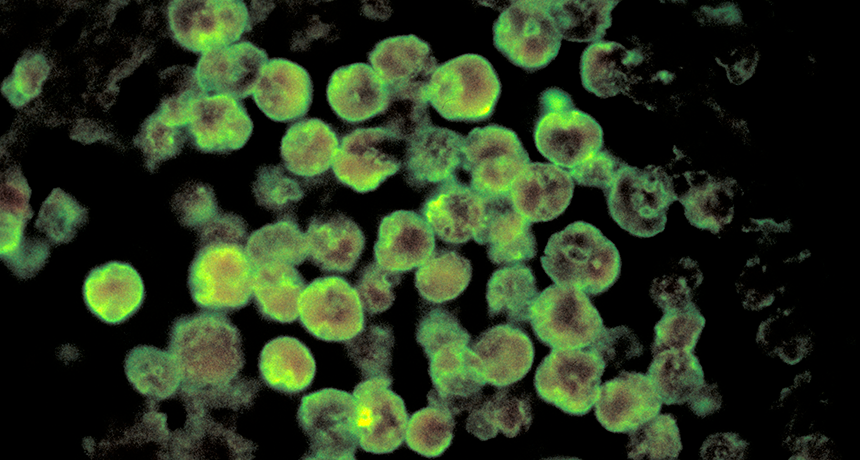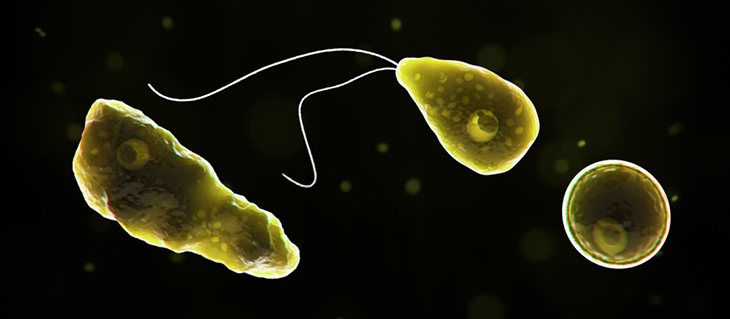Silver nanoparticles help fight brain-eating amoebas
Novel treatment boosts how well drugs work

Parasites belonging to the species Naegleria fowleri, sometimes known as brain-eating amoebas, can destroy brain tissue — and kill human victims within a week.
Govinda S. Visvesvara/CDC
By Dan Garisto
Brain-eating amoebas are the stuff of nightmares. People infected with these microscopic monsters typically die within a week. To treat infections, doctors currently use a chemical cocktail of drugs. Even with treatment, however, these parasites usually prove fatal. But that may change. In fact, a new silver “bullet” might — quite literally — prove their downfall.
Researchers in Malaysia report that silver nanoparticles can make drugs more effective as they fight off brain-eating amoebas. The scientists began by growing two kinds of these parasites in test tubes. Both have unruly names. One is Acanthamoeba castellanii (Ah-KAN-thuh-MEE-buh Kas-tel-LAHN-ee-eye). The other is Naegleria fowleri (NAYG-lehr-ee-uh Fow-LAER-ee). The researchers treated these amoebas with drugs. Some got only the drugs. Others got the drugs together with a dose of silver nanoparticles. The silver greatly boosted the killing power of most drugs, the new study reports.
Marion Paolini is a cancer scientist working at the Massachusetts Institute of Technology in Cambridge. Although not involved in the new work, she does find the new treatment “promising.” However, she notes “it would still have to be proven in vivo.” By that, she means it needs to be tested in people or some other animal, not just in the test tube.
The new research was published October 15 in ACS Chemical Neuroscience.

What inspired the new treatment
Brain-eating amoebas are rare. Only a few hundred infections have ever been reported. But the outcome for people who do become infected is grim. About 98 out of every 100 infected people die. Sometimes, the amoebas literally eat away parts of their brains. Other times, the microbes cause a fatal swelling in the brain.
Ayaz Anwar is a biologist at Sunway University in Sunway City, Malaysia. He became interested in these microscopic parasites after one of his relatives died from an amoebic infection.
“We don’t know what can kill the infection,” Anwar says. Currently, doctors prescribe a mix of several different drugs. This includes drugs that kill cancer cells and fungi. It’s unclear which of those drugs have helped the few people who have survived, he says.
These drugs typically are injected into the blood. From there, they move throughout the body. Yet few of them can pass from the blood into the brain, where the infection can hide. Anwar’s team decided to use a drug that could pass from the blood to the brain. Anti-seizure drugs do this. Some scientists had suspected these drugs might be effective against amoebas. An added benefit, Anwar notes: These anti-seizure drugs are known to be safe.
To test the drugs’ amoeba-killing power, the Sunway team grew amoebas in test tubes and counted them. Then they treated the parasites with one of three drugs: valium, luminal or dilantin. Each of these anti-seizure drugs fought both amoeba species — killing some, but not all of them.
Anwar thought they could do better.
Their second innovation
“Only a little amount of a drug can reach the target,” he notes. Free-floating drugs often get lost, especially in the human body. So he enlisted the use of nanoparticles to work “like a courier service.” Basically, they help carry more of the drug to the brain infection.
Silver nanoparticles are about a millionth the size of a baseball. Drugs stick to these tiny silver balls, like noodles around a meatball. This prevents the drugs from floating away before they reach the amoebas. Silver itself can also kill cells. Anwar suspected that by combining it with the seizure meds, the duo might prove a double whammy against the single-celled parasites.
And his team’s new data suggest he was right.
They tested each of the three drugs alone and again with the nanosilver. That silver boosted the ability of the seizure drugs to kill amoebas. Against A. castellani, the silver more than tripled each drug’s ability to kill amoebas. It didn’t work quite as well against N. fowleri. Those nanoparticles boosted the amoeba-killing value of only valium and luminal.
Previous work by Anwar’s team had hinted that nanosilver might help other drugs fight amoebas. The new tactic — pairing them with anti-seizure drugs — appears to show real promise. Still, the new treatment is a long way from being ready for use in people. But Anwar already has a plan for how to apply the silver nanoparticles and drugs. He wants to spray them up your nose.
“These amoebas enter the brain through the easiest route,” he says. That often is up through the nose. Earlier this year, a news report described a woman who died from brain-eating amoebas. The source? She had rinsed out her nose with water that later turned out to be infected.
“What we propose is that we can also follow the same track of the amoebas,” says Anwar. Doctors can deliver the drug as a nasal spray.
But Paolini has a word of caution.
“Silver nanoparticles’ advantages are also their drawbacks: They can be toxic, and can kill bacteria and tumor cells,” she says. So, she warns, “Without proper targeting, they can also be toxic to healthy cells.”
That’s why the next step by Anwar’s team is testing the new therapy in mice. That can serve as a first test of the combo’s safety.
This is one in a series presenting news on technology and innovation, made possible with generous support from the Lemelson Foundation.







